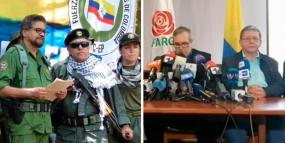The division of the FARC into two groups creates a new situation, and it becomes more urgent to clarify what we are talking about when we talk about peace.
Although Iván Márquez’s arguments justifying the decision to go back to war make some sense — since the current government is the main party responsible that has failed to make good on the agreement — it is also a decision that affects the whole country in general, and the grassroots of the party in particular. The guerrillas who are resuming operations consider it naïve, a mistake, to have laid down their arms; consequently, they are trying to convey these sentiments to other ex-combatants who are discontented with the implementation of the agreement and worried about the continued murderous attacks on their numbers, in the hopes of getting them to join the new insurgency. It is therefore important to realize that:
The new guerrillas include members of the old guerrilla movement: Iván Márquez, Jesús Santrich, “Romaña,” and “El Paisa,” among others seen in the video. They know how to wage resistance warfare; they have experience in the jungles and the mountains of this country. There will be battles with the paramilitaries, who have undergone a recrudescence in the past year, and the influence of newly rampant drug trafficking will be felt.
We are witnessing a wave of violence which, although its roots run deep, is operating within a different set of dynamics as a consequence of the peace process, and ultimately the reconfiguration of the conflict. The aggressiveness of the current government is threatening to destroy what has been built. The tendency inherited from Álvaro Uribe (the Centro Democrático party, led by the former president and senator himself) knows no other way of doing politics than to sow fear and terror. This tendency is the main beneficiary of the decision by one faction of the guerrillas to resume the fight, but they are not the only ones responsible for this situation.
In theory, the national government should be protecting the reintegration zones and preventing more ex-combatants from taking up arms again. This will probably not happen, since the government has taken a rejectionist tack: it denies the systematic assassination of social movement leaders; it considers paramilitarism a thing of the past; it disagrees that the FARC has strictly held up its end of the bargain; it invokes the memory of the conflict and the suffering of the victims for its own ends. The social movement has been targeted with unending judicial and political persecution, including threats, jail terms, and exile.
Nor has this government listened to the ELN, which continually expresses a willingness to engage in dialogue even as the fighting continues. The government ignores demands by international organizations to uphold the agreements. It sidelines the peace process while launching attacks on Venezuela, carrying on the tradition of subordination to US imperialism.
It should be emphasized that only the Uribist right and the most dogmatic left groups are celebrating this manifesto, and not only in Colombia. In other Latin American countries, for example, certain leftists, from their comfort of their urban homes, are celebrating the armed struggle. They know nothing of the subtleties of the situation in Colombia and of the fact that, in this conflict, it is the poor who die. On social networks in Spain, Stalinist sects can be found glorifying the armed struggle without providing any form of context, or noting that in this case, the goals of armed struggle have little to do with the pursuit of socialist goals.
In any case, it is urgent to debate the conception of peace that Colombia needs, and the methods for achieving it: by taking to the streets, but this time controlling them; by disputing the meaning of our historical memory, and by denouncing the crimes of the state in the international arena, since disinformation and the media slant on the conflict are serious problems. Thus, when attempting to define peace, an ultra-pacifist stance is just as reprehensible and harmful as an ultra-aggressive one. To be pro-peace is to understand that there are multiple paths and that we must choose one that diverges from both passivity and selective indignation.
Finally, it should be noted that the violence in Colombia is, by its nature, linked to the capitalist system. The post-agreement model was configured without consideration of the peace, and the strategy adopted was that of prioritizing the profits of the large corporations. It can also be construed as a neoliberal peace. Peace should not be thought of as a moment or a spiritual state; it calls for a definition that can accommodate conflict and confrontation between differing models of nation and society. In this connection, a 2016 quote from former minister of the Treasury Juan Carlos Echeverry is relevant: “Day by day, peace becomes more and more important to the Colombian economy, for it will help us build a new economy… After the boom in basic goods, petroleum, and minerals, this new economy will be built upon agriculture, tourism, industry, and sectors that are critically dependent on instilling a durable peace.”
